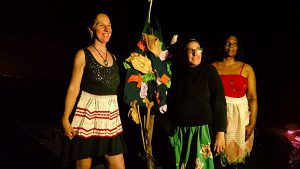NAEA Women’s Caucus Retreat, August 8-9, 2015, Ohio

Thanks to Karen Keifer-Boyd for hosting WC members at her lakefront home in Ohio in August for an informal retreat to bring together members for dialogue. Participants reflected that the retreat was full of “great conversation and sharing of time together in powerful ways” and a “powerful and an inspiring way to walk into a new teaching year.”Some of the highlights were telling apron stories around the bonfire and returning to the academic gown. The academic gown, along with an apron, were brought to the Lobby Session in San Diego in 2014 to explore as symbols of power. Participants of the 2014 Lobby Session responded by writing a phrase or quote onto a piece of fabric that they attached to the apron, or gown. Responses were read aloud and were amplified by the group. At the retreat, we again read aloud each response and kept the fabric pieces as artifacts. It is likely that a discussion of the apron and gown will resurface in the upcoming Women’s Caucus Lobby Activism Book edited by Karen Keifer-Boyd, Linda Hoeptner-Poling, Sheri Klein, Adetty Pérez de Miles, and Wanda Knight.
Artist’s Apron Symbolizes Feminist Power

The artist apron symbolizes feminist power. While aprons have been associated with housework,
the artists’ work apron symbolizes both the intellectual work and labor of artistic production.
Aprons have enjoyed a recent resurgence in style and popularity, with both men and women
wearing many different types of aprons as an intentional choice. “Our” art educator’s apron
supports and encourages art teachers as they confront an often highly feminized art education
environment in strong and assertive ways.
The academic gown symbolizes patriarchal power, and the hierarchies within educational
institutions that often run counter-productive to creating equitable and just teaching, learning, and
working environments. Academic regalia worn by graduates at commencements—from
kindergarten ceremonies to high school and university degrees—follow a tradition begun in the
Middle Ages by men at European universities to denote educational status to men. Today, many
women achieve advanced degrees and don the male garb at graduation ceremonies.
More information about artist’s apron as feminist power from the 2014 San Diego Lobby Activism session.





